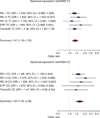A genome-wide association study identifies a susceptibility locus for refractive errors and myopia at 15q14
- PMID: 20835239
- PMCID: PMC4115149
- DOI: 10.1038/ng.663
A genome-wide association study identifies a susceptibility locus for refractive errors and myopia at 15q14
Abstract
Refractive errors are the most common ocular disorders worldwide and may lead to blindness. Although this trait is highly heritable, identification of susceptibility genes has been challenging. We conducted a genome-wide association study for refractive error in 5,328 individuals from a Dutch population-based study with replication in four independent cohorts (combined 10,280 individuals in the replication stage). We identified a significant association at chromosome 15q14 (rs634990, P = 2.21 × 10⁻¹⁴). The odds ratio of myopia compared to hyperopia for the minor allele (minor allele frequency = 0.47) was 1.41 (95% CI 1.16-1.70) for individuals heterozygous for the allele and 1.83 (95% CI 1.42-2.36) for individuals homozygous for the allele. The associated locus is near two genes that are expressed in the retina, GJD2 and ACTC1, and appears to harbor regulatory elements which may influence transcription of these genes. Our data suggest that common variants at 15q14 influence susceptibility for refractive errors in the general population.
Figures



References
-
- Bourne RR, Dineen BP, Ali SM, Noorul Huq DM, Johnson GJ. Prevalence of refractive error in Bangladeshi adults: results of the National Blindness and Low Vision Survey of Bangladesh. Ophthalmology. 2004;111:1150–1160. - PubMed
-
- Dandona R, et al. Population-based assessment of refractive error in India: the Andhra Pradesh eye disease study. Clin. Experiment. Ophthalmol. 2002;30:84–93. - PubMed
-
- Kempen JH, et al. The prevalence of refractive errors among adults in the United States, Western Europe, and Australia. Arch. Ophthalmol. 2004;122:495–505. - PubMed
-
- Sawada A, et al. Refractive errors in an elderly Japanese population: the Tajimi study. Ophthalmology. 2008;115:363–370. - PubMed
Publication types
MeSH terms
Substances
Associated data
- Actions
Grants and funding
LinkOut - more resources
Full Text Sources
Molecular Biology Databases

